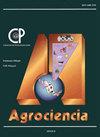DRY BREWER GRAINS AS REPLACEMENT FOR ALFALFA IN DIETS FOR LACTATING EWES
IF 0.5
4区 农林科学
Q4 AGRICULTURE, MULTIDISCIPLINARY
引用次数: 0
Abstract
The settlement of small and medium breweries in cities leads to the production of nutrient-rich organic residues, the quick decomposition of which causes unpleasant odours and attracts large amounts of flies. Under the hypothesis that replacing alfalfa (lucerne) with dry brewer grains (DBG) for lactating ewes would modify their milk production and physicochemical quality. The aim was to determine the effect of the DBG supplementation in the feed of ewes in milk production and quality, as well as in the physical condition of the animals. Fifteen 18-month-old ewes from a cross between Friesian × Rambouillet resulting from a first birth (30 days on milk) were distributed into 3 treatments with 0, 150 or 300 g of DBG. The experiment had a duration of 30 days, in which milk production, feed intake and physicochemical characteristics of the milk (fat, non-fatty solids, density, cryoscopic point, protein, lactose, and salts) were measured and each week the intake of feed in dry mass and the change in body weight were registered. Milk production displayed no differences between treatments and a decrease was observed in the production of milk for all treatments between weeks one (462 mL) and four (162 mL). Physicochemical variables of the milk displayed no differences between treatments, and quality was not affected. The change in body weight was the highest in the 300 g DBG treatment, with a modification of approximately 12.8 ± 0.45 kg (p ≤ 0.05) during the trial time, daily weight gain was 440 ± 0.08 g d-1 (p ≤ 0.05). The implementation of DBG in the feeds of ewes reduced the intake of dry matter, food conversion improved, and the cost of feed per ewe was reduced by up to 33.8 %.干啤酒糟在泌乳期母羊饲粮中替代苜蓿的研究
中小型啤酒厂在城市的定居导致了富含营养的有机残留物的产生,这些残留物的快速分解会产生难闻的气味,并吸引大量的苍蝇。以干啤酒糟(DBG)代替紫花苜蓿(lucerne)饲喂哺乳期母羊,可以改善母羊的产奶量和理化品质。目的是确定在母羊饲料中添加DBG对产奶量和质量的影响,以及对动物身体状况的影响。选取首产(30 d)的15只18月龄弗里斯×朗布依埃杂交母羊,分为3个处理,DBG分别为0、150和300 g。试验为期30 d,测定奶牛的产奶量、采食量和乳的理化特性(脂肪、非脂肪固体、密度、低温点、蛋白质、乳糖、盐类),每周记录干质量采食量和体重变化。产奶量在处理之间没有差异,在第一周(462毫升)和第四周(162毫升)之间,所有处理的产奶量都有所减少。不同处理的牛奶理化指标无差异,质量不受影响。300 g DBG组体重变化最大,试验期间体重变化幅度约为12.8±0.45 kg (p≤0.05),日增重为440±0.08 g d-1 (p≤0.05)。在母羊饲料中添加DBG降低了母羊干物质采食量,提高了食物转化率,每只母羊的饲料成本降低了33.8%。
本文章由计算机程序翻译,如有差异,请以英文原文为准。
求助全文
约1分钟内获得全文
求助全文
来源期刊

Agrociencia
农林科学-农业综合
CiteScore
0.50
自引率
33.30%
发文量
51
审稿时长
18-36 weeks
期刊介绍:
AGROCIENCIA is a scientific journal created and sponsored by the Colegio de Postgraduados. Its main objective is the publication and diffusion of agricultural, animal and forestry sciences research results from mexican and foreign scientists. All contributions are peer reviewed. Starting in the year 2000, AGROCIENCIA became a bimonthly and fully bilingual journal (Spanish and English versions in the same issue). Since 2007 appears every month and a half (eight issues per year). In addition to the printed issues, the full content is available in electronic format.
 求助内容:
求助内容: 应助结果提醒方式:
应助结果提醒方式:


